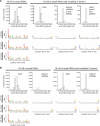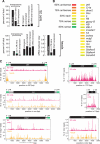Endogenous siRNAs derived from transposons and mRNAs in Drosophila somatic cells
- PMID: 18403677
- PMCID: PMC2953241
- DOI: 10.1126/science.1157396
Endogenous siRNAs derived from transposons and mRNAs in Drosophila somatic cells
Abstract
Small interfering RNAs (siRNAs) direct RNA interference (RNAi) in eukaryotes. In flies, somatic cells produce siRNAs from exogenous double-stranded RNA (dsRNA) as a defense against viral infection. We identified endogenous siRNAs (endo-siRNAs), 21 nucleotides in length, that correspond to transposons and heterochromatic sequences in the somatic cells of Drosophila melanogaster. We also detected endo-siRNAs complementary to messenger RNAs (mRNAs); these siRNAs disproportionately mapped to the complementary regions of overlapping mRNAs predicted to form double-stranded RNA in vivo. Normal accumulation of somatic endo-siRNAs requires the siRNA-generating ribonuclease Dicer-2 and the RNAi effector protein Argonaute2 (Ago2). We propose that endo-siRNAs generated by the fly RNAi pathway silence selfish genetic elements in the soma, much as Piwi-interacting RNAs do in the germ line.
Figures




Comment in
-
Molecular biology. Slicing and dicing for small RNAs.Science. 2008 May 23;320(5879):1023-4. doi: 10.1126/science.1159018. Epub 2008 May 8. Science. 2008. PMID: 18467555 No abstract available.
References
-
- Gunawardane LS, et al. Science. 2007;315:1587. published online 21 February 2007 (10.1126/science.1140494) - PubMed
-
- Brennecke J, et al. Cell. 2007;128:1089. - PubMed
-
- Vagin VV, et al. Science. 2006;313:320. published online 28 June 2006 (10.1126/science.1129333) - PubMed
-
- Yin H, Lin H. Nature. 2007;450:304. - PubMed
Publication types
MeSH terms
Substances
Associated data
- Actions
- Actions
Grants and funding
- GM65236/GM/NIGMS NIH HHS/United States
- R01 GM062862/GM/NIGMS NIH HHS/United States
- R01 HG003367/HG/NHGRI NIH HHS/United States
- GM080625/GM/NIGMS NIH HHS/United States
- R01 GM080625/GM/NIGMS NIH HHS/United States
- F30 AG030283/AG/NIA NIH HHS/United States
- HHMI/Howard Hughes Medical Institute/United States
- R01 GM065236/GM/NIGMS NIH HHS/United States
- HG003367/HG/NHGRI NIH HHS/United States
- R37 GM062862/GM/NIGMS NIH HHS/United States
- P30 AI042845/AI/NIAID NIH HHS/United States
- R01 AI043208/AI/NIAID NIH HHS/United States
- F30AG030283/AG/NIA NIH HHS/United States
- GM62862/GM/NIGMS NIH HHS/United States
LinkOut - more resources
Full Text Sources
Molecular Biology Databases

